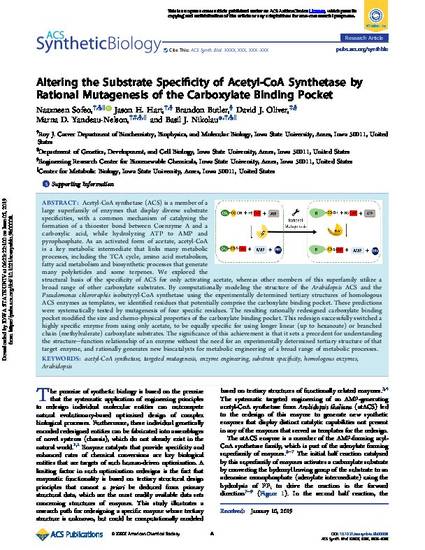
Acetyl-CoA synthetase (ACS) is a member of a large superfamily of enzymes that display diverse substrate specificities, with a common mechanism of catalyzing the formation of a thioester bond between Coenzyme A and a carboxylic acid, while hydrolyzing ATP to AMP and pyrophosphate. As an activated form of acetate, acetyl-CoA is a key metabolic intermediate that links many metabolic processes, including the TCA cycle, amino acid metabolism, fatty acid metabolism and biosynthetic processes that generate many polyketides and some terpenes. We explored the structural basis of the specificity of ACS for only activating acetate, whereas other members of this superfamily utilize a broad range of other carboxylate substrates. By computationally modeling the structure of the Arabidopsis ACS and the Pseudomonas chlororaphis isobutyryl-CoA synthetase using the experimentally determined tertiary structures of homologous ACS enzymes as templates, we identified residues that potentially comprise the carboxylate binding pocket. These predictions were systematically tested by mutagenesis of four specific residues. The resulting rationally redesigned carboxylate binding pocket modified the size and chemo-physical properties of the carboxylate binding pocket. This redesign successfully switched a highly specific enzyme from using only acetate, to be equally specific for using longer linear (up to hexanoate) or branched chain (methylvalerate) carboxylate substrates. The significance of this achievement is that it sets a precedent for understanding the structure–function relationship of an enzyme without the need for an experimentally determined tertiary structure of that target enzyme, and rationally generates new biocatalysts for metabolic engineering of a broad range of metabolic processes.
Available at: http://works.bepress.com/basil-nikolau/45/

This article is published as Sofeo, Naazneen, Jason H. Hart, Brandon Butler, David J. Oliver, Marna D. Yandeau-Nelson, and Basil J. Nikolau. "Altering the substrate specificity of acetyl-CoA synthetase by rational mutagenesis of the carboxylate binding pocket." ACS synthetic biology (2019). doi: 10.1021/acssynbio.9b00008.